Shrimply Explained is currently undergoing renovations. Please don't buy anything yet. Thank you!
When most people think about keeping Neocaridina shrimp, they picture vivid cherry reds, electric blue dreams, or striking orange rilis. Wild type shrimp with their mottled brown coloration? Not so much. They're often dismissed as "boring" or what happens when you "ruin" a colony by mixing colors.
But here's what most shrimp keepers don't realize: wild type shrimp offer unique advantages that pure-bred lines simply can't match. From surprising color variety in offspring to superior hardiness and better survival rates with fish, wild type Neocaridina might actually be the perfect choice for your tank – especially if you've struggled with shrimp keeping in the past.
Let's explore why wild type shrimp deserve more appreciation and when they might be exactly what your aquarium needs.
Other Shrimp Content
We have a lot of content coming soon. Please follow us on social media and subscribe to our newsletter for updates and useful shrimp care tips!
Before we dive into the benefits, let's clarify some terminology that often confuses shrimp keepers.
True Wild Type Shrimp
Technically, a wild type (WT) shrimp refers to a shrimp that retains the natural coloration and patterns before being selectively bred. In the case of Neocaridina like cherry shrimp, a WT shrimp typically has a mottled red-brown coloration, although it varies significantly. This camouflage coloration is what wild Neocaridina developed naturally to hide from predators in their native habitats.
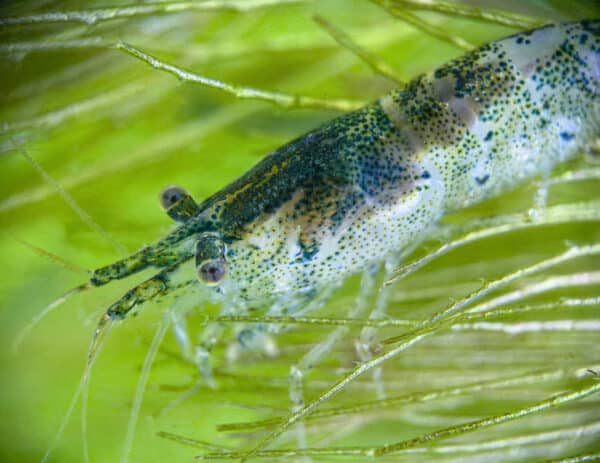
Skittles Tanks and Mixed Colonies
When multiple pure-bred lines of one species are kept in a single tank, it's officially known as a skittles tank (or “skrittles” as LRB Aquatics likes to call them – this link is also a great example of the variety of colors in a skittles tank). These different breeds mate and produce offspring that are not pure-bred and therefore display a variety of colors. Some of these offspring may look like the original WT shrimp, while others retain vibrant colors from their parents or display entirely new color combinations.
Important Clarification For This Article
For the purposes of this article, we're referring to all non-pure-bred Neocaridina as "wild type" or "WT," regardless of their specific coloration. This includes shrimp from mixed colonies, reversion shrimp from pure-bred lines, and true wild type specimens.
A word of caution: Shrimp sold as "Skittles" by some vendors are often pure-bred individuals of lower quality rather than true mixed colonies. These may not have all the benefits we discuss in this article, as they still suffer from the genetic limitations of their pure-bred lineage.
While we mainly refer to Neocaridina in this article, the same reasoning applies to wild type Caridina species as well.
WT offspring are anything but boring - They display a surprising variety of colors throughout generations. Yes, brown appears frequently, but you'll also see other interesting patterns and shades. This is because any common ancestors from the family tree can appear in the tank as genetics mix and recombine.
The Genetic Lottery
For example, if you mix a Blue Dream Neocaridina with an Orange Rili, their offspring may look like:
It's genuinely exciting to watch the offspring develop and see what they grow up to look like. Every breeding cycle brings surprises when we look into our tank and see unique patterns developing on each tiny baby shrimp.
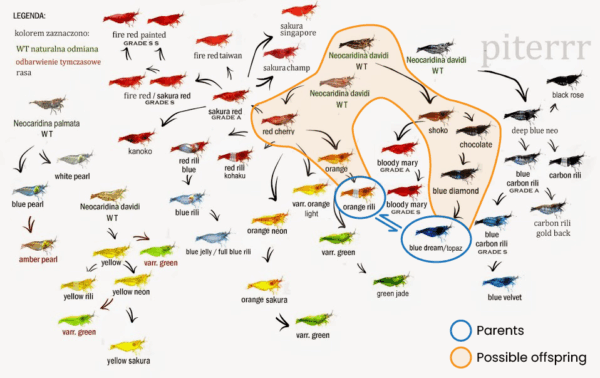
The Neocaridina family tree gives us an idea of where each pure-bred line comes from. We can trace back the lineage of the parents to find some of the possible offspring variations!
This is perhaps the most important advantage, especially for beginners or anyone who has struggled with shrimp mortality.
The Genetic Diversity Advantage
WT shrimp have significantly more genetic variation than pure-bred shrimp. This genetic diversity reduces inbreeding issues that many pure-bred shrimp populations experience. When shrimp are selectively bred for specific colors over many generations, the gene pool becomes increasingly narrow, leading to inbreeding depression as detrimental recessive traits appear more frequently. This effect partially explains why Neocaridina and Caridina seem to be more susceptible to stress than many organisms in the aquarium hobby, and is especially true for newer pure-bred lines.
The benefits of genetic diversity in WTs include:
Side Note: An inbreeding depression is a common problem for any small population of animals. As wild populations diminish or small populations become cut off from a larger population by roads or fences, they experience many of the same issues pure-bred shrimp do, except they don’t have breeders introducing new genetics into the population. This makes it very difficult to bring species back after being endangered, as their gene pool remains small even if their population recovers. One example of this inbreeding depression involves mountain lions in Southern California, which you can read more about in this paper.
WTs Are The Best Choice For Difficult Situations
If you've struggled with keeping shrimp alive in the past, WT shrimp are your best chance of success. Their adaptability means they're more forgiving of less-than-perfect water parameters, fluctuations in temperature, or other environmental stressors that might wipe out a colony of pure-bred shrimp.
This makes them ideal for:
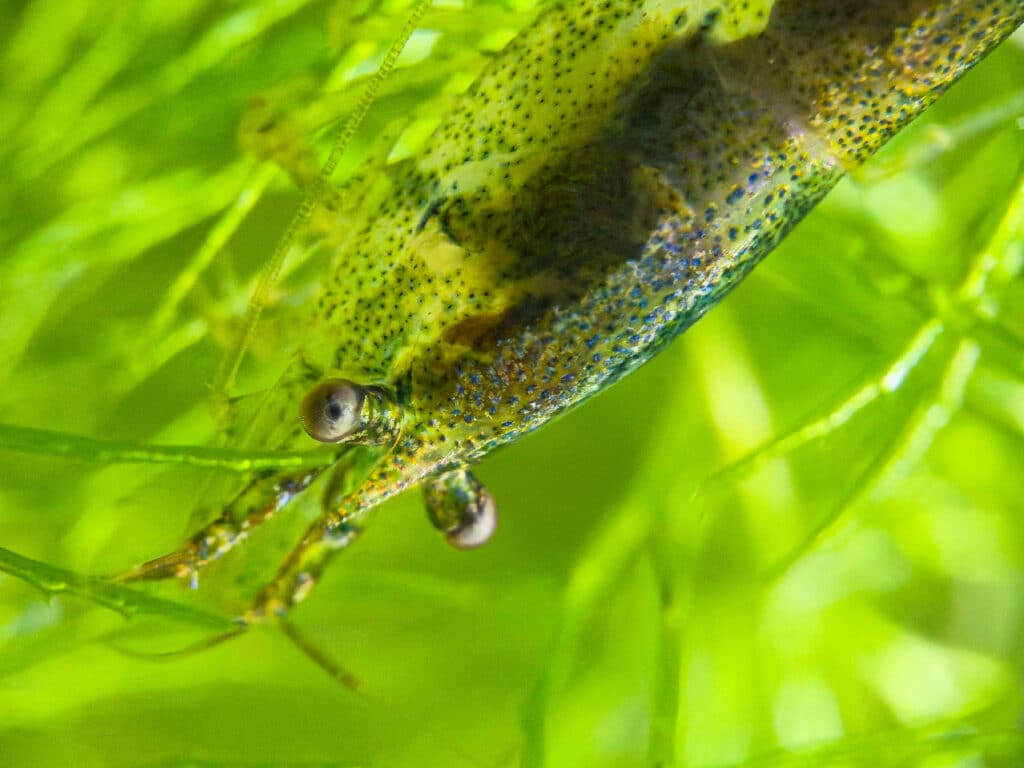
Want to keep shrimp in a community tank with fish? Wild type coloration gives them a fighting chance.
Natural Camouflage At Work
A large reason why wild shrimp naturally developed their WT coloration is to camouflage from predators. The mottled colors blend in significantly better with natural environments, making it harder for fish to spot them. While a bright red cherry shrimp stands out like a neon sign saying "eat me," a wild type shrimp can virtually disappear against a background of brown substrate and green plants.
This doesn't make them completely safe from fish predation – hungry fish will still hunt them – but it dramatically improves their survival rate compared to their brightly colored cousins.
An Unexpected Bonus: Hide and Seek Entertainment
This camouflage might sound like a problem, since bright colors are why many shrimp keepers have shrimp in the first place. It’s true that WT shrimp may be harder to see but it also creates a fun little hide-and-seek game. You might be watching a floating plant spiraling in the current of your filter when suddenly you notice a cool shrimp with blue-black spots and transparent green markings hanging onto the plant. These moments of discovery make observing the tank more engaging and rewarding.
There’s also still a lot of color to be appreciated. The subtle beauty of well-camouflaged shrimp often surprises people once they start looking for them. The patterns and colors are still there – browns, greens, subtle blues, transparent sections – they're just distributed in a way that breaks up the shrimp's outline rather than highlighting it.
Let's address the practical consideration that matters to most hobbyists: budget.
Better Value For Your Money
If cost is a concern (and when is it not?), then WT shrimp are an excellent option. They offer:
Cost Comparison
While high-quality Neocaridina shrimp might cost $3-5 per shrimp, wild type or mixed colony shrimp typically cost $1-3 per shrimp. For someone starting a colony of 10-20 shrimp, that's a difference of $40-100 or more.
This lower price point also means less anxiety about losses during the acclimation period or from beginner mistakes. Losing a $10 shrimp to a water parameter mishap is significantly more painful than losing a $2 wild type.
Investment in Volume
The money saved on individual shrimp can be redirected to:
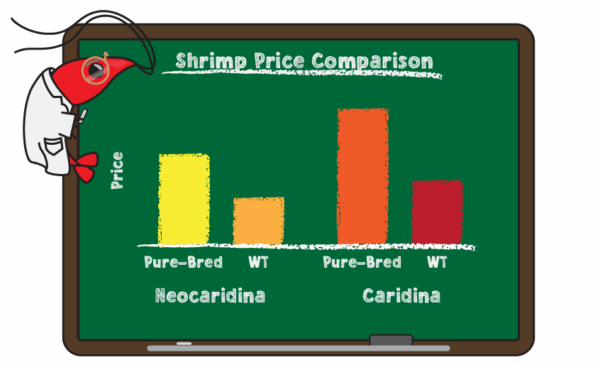
Based on the advantages we've covered, wild type Neocaridina are particularly well-suited for:
Wild type shrimp are also perfect for anyone who appreciates natural beauty over artificially selected traits. There's something satisfying about keeping creatures that look similar to their wild ancestors, displaying the colors and patterns that evolution perfected over millennia.
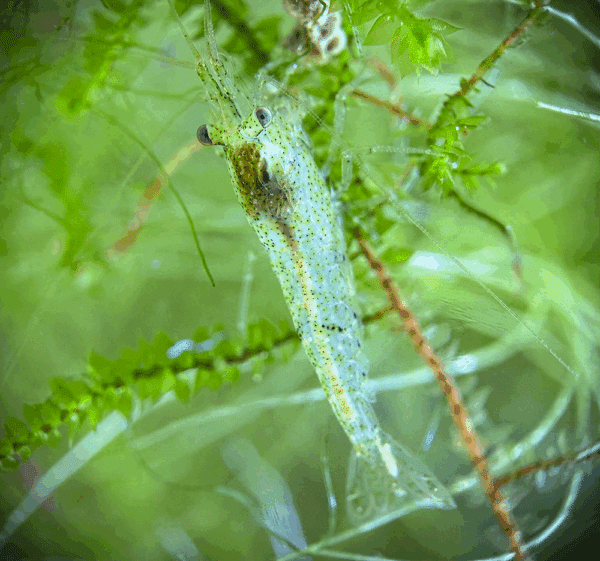
If you want to keep your wild type colony from becoming too brown over several years, here are some strategies:
Selective culling: Periodically remove the plainest brown individuals and keep the more colorful ones. This doesn't need to be aggressive – just gently guiding the population toward retaining color.
Periodic introduction of new genetics: Every year or two, add a few high-quality colored individuals to refresh the gene pool and introduce new color possibilities.
Separate breeding projects: If you fall in love with a particular color that appears, you can always separate those individuals and try to establish a pure line while maintaining your main wild type colony.

Like what you're reading?
Our eBook, The Science of Shrimp Keeping, has tons of practical shrimp keeping advice you won't find anywhere else. Over 300 pages of Shrimply Explained information backed by 150+ scientific citations.
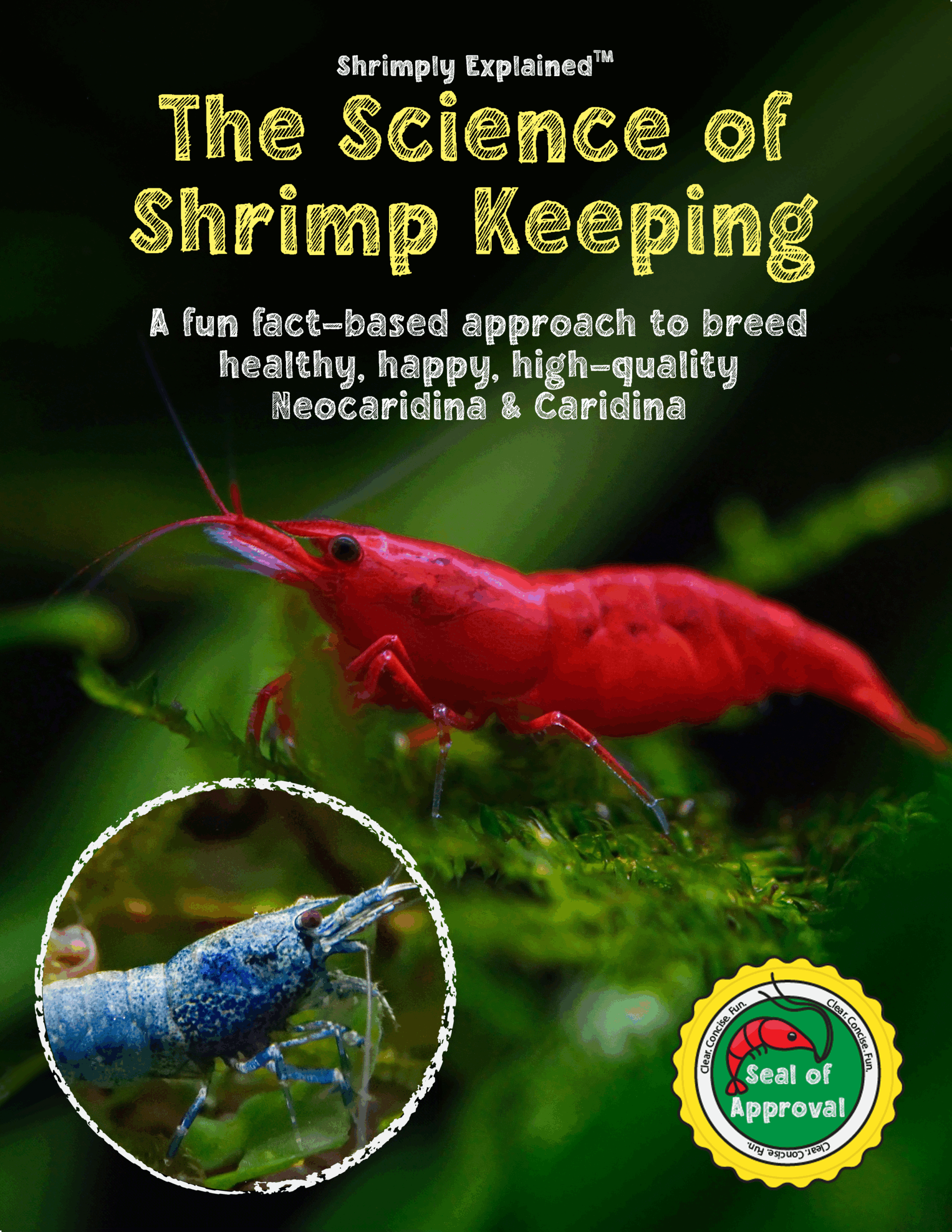
Neocaridina
If you search “mixed Neocaridina” the main results are skittles packs. These are typically pure-bred shrimp that are culled from existing colonies due to “undesirable” coloration. They won’t have the hardiness of mixed lines but will produce varied and hardy offspring. To get hardier shrimp, search for “wild type neocaridina” online or ask around in local Facebook/Reddit groups like r/aquaswap.
Caridina
Your best chance of finding WT Caridina is to search “mixed Caridina” on Google or r/aquaswap, or ask around local FB groups. Keep in mind that some mixed bundles may be shrimp from cull tanks that are still pure-bred. They are surprisingly difficult to find as many online sellers are sold out at the time of writing this article (Oct 2025).
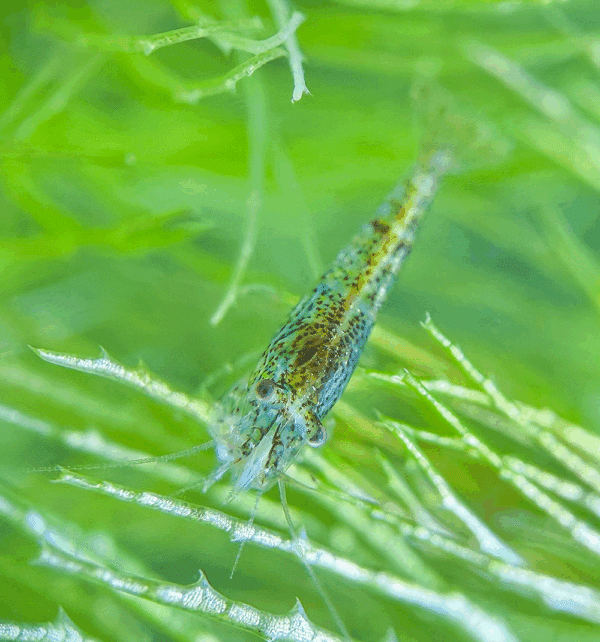
Wild type Neocaridina shrimp deserve far more credit than they typically receive in the shrimp keeping community. While they may not have the Instagram-worthy uniformity of a tank full of blood-red cherries or electric blue dreams, they offer advantages that pure-bred lines simply can’t match.
Their genetic diversity translates to hardier shrimp that breed reliably, resist disease better, and adapt to a wider range of conditions. Their natural camouflage gives them better survival odds in community tanks. Their offspring provide an ongoing surprise element as new colors and patterns emerge. Lastly, their lower cost makes them accessible to more hobbyists while reducing the anxiety of potential losses.
For beginners, wild type shrimp offer the best chance of success in the hobby. For experienced keepers, they provide a reliable, low-maintenance colony that can thrive in situations where finicky pure-bred lines might struggle. For everyone, they offer the satisfaction of keeping shrimp that retain the beauty and resilience that nature designed.
The next time you see "wild type" or "mixed" shrimp available, don't dismiss them as inferior. They might just be exactly what your tank needs – and you might be surprised by how beautiful and fascinating they turn out to be.
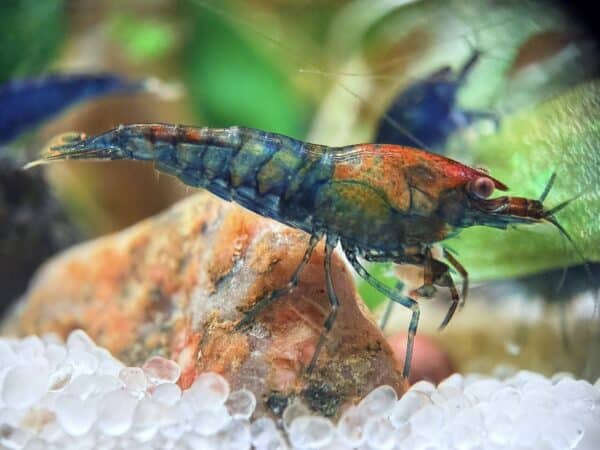
Pssst... Want to learn everything you need to know to have happy and healthy freshwater shrimp? We've got you covered with clear, concise, and fun information in every lesson of The Shrimp School!
You know it's true because we have a badge.